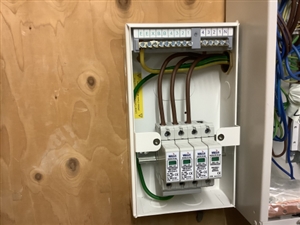
davezawadi (David Stone):
This is another deviation from the original post but it may be worthwhile to discuss.
The important feature of any surge protection is the slope resistance of the supposed limiting action. This comes from how quickly and effectively the SPD changes from being an insulator to a "perfect" conductor. The element in most of these devices is called a "Voltage dependant resistor", VDR, which have quite a high slope resistance. This can be seen by various tests, but strangely not the famed 8/20 test in the specification. Imagine for a moment that I have a large surge from a lightning strike on the HV system, which puts a surge onto the mains with an available current of 1kA. Fair enough you say, the VDR will limit it to a few hundred volts, but will it? To pass 1kA the resistance above the threshold must be very small, less than 0.2 Ohms. to reduce the voltage to about 230V. None of the devices currently on sale can come anywhere near doing this, in fact, many would fail completely and permanently! There are two parts to this, one is the current available from the surge, and the other is the impedance of the supply at the surge protection point. In the 8/20 test, the source current available is very small (it is capacitively coupled to the phase line) from a high impedance source, and so any slope resistance will show the transient much attenuated (note not removed). This is fine for a bit of switching somewhere far away, or some similar disturbance, but is zero protection from the problem transients that have significant current available. These are the transients that may damage electronics because protection against small ones is easy and built into any reliable design. Note that I (and the specification) are expecting the device to dissipate something like 1MJ.
This then leads to the question: Just what are these surge protectors doing in my CU? I have no idea, they certainly do not offer lightning protection, although sold on this basis!
If anyone wishes to question or comment it would be best to start a new thread! You may copy my post into the header.
Any properly designed appliances should be able to withstand a few kV for a brief moment (I think it's 4kV, but I could be wrong on that). So there's no need to clamp the voltage all the way down to 230V. When subjected to a large spike, the SPD will probably fail short circuit, and will remain shorted until the internal fuse blows.
But nothing is going to protect against a direct lightning strike on an overhead cable leading to your home. It's more like handling lightning elsewhere, such as on the HV network.
davezawadi (David Stone):
Simon, you have the wrong end of the stick. I said a HV strike, potentially many miles away.
You are right about very low power surges, the electronics looks after itself. So what is the purpose of the SPD? BS7671 says to protect against lightning surges, so I discuss them. You answer that nothing can protect against them, not necessarily true, but certainly not VDR based low power products. So what are they for? That is the question, as the Bard said. The slope resistance even at 4kV is still considerable, and unless operating against some significant impedance still cannot LIMIT the voltage. The only device which actually does is the Zener diode which has a low slope resistance and little inherent current limiting. Diodes with sufficient power rating to use for surge protection are quite expensive, many times the cost of a VDR (which is pence). A string of fairly low voltage diodes would be required, so even more expense, and as they are unidirectional two strings (or possibly a very high voltage bridge rectifier with a high current rating) would be necessary.
SPDs per 443 and 534 are NOT intended to protect against a DIRECT strike to the building.
The impedance in the supply network helps address overvoltages due to remote atmospheric activity.
The other thing that BS 7671 SPDs protect against is overvoltages due to switching surges
We're about to take you to the IET registration website. Don't worry though, you'll be sent straight back to the community after completing the registration.
Continue to the IET registration site